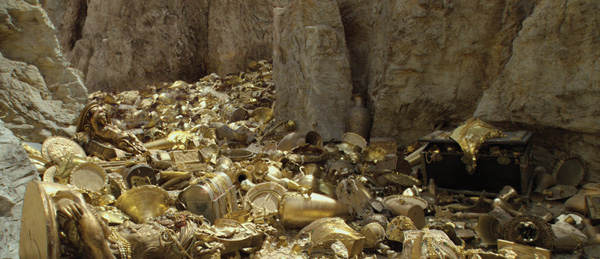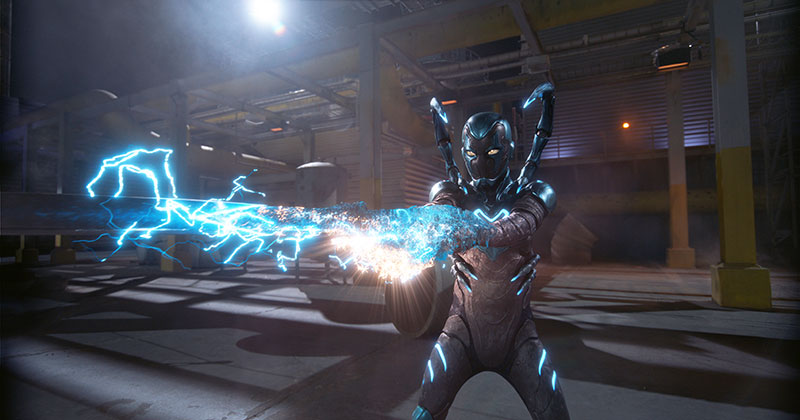  |
| Interior Weather When Lucy Pevensie enters the enchanted house of the magician Coriakin, she finds herself in his library where she reads from a book of magical spells standing on a lectern. As she blows the dust off of it, a jumble of letters on the cover suddenly animate and rearrange themselves into the book's title, 'The Book of Incantations'. As she opens the book and reads one of the spells, a snow flake drifts down onto the page – added in 3D CG. From there, the camera shifts into a reverse angle looking up at her, and when it changes back again and she looks up, a completely 3D CG environment of the library itself is revealed, this time with falling snow and clouds, resulting from the spell she read out that has brought the weather system inside. The entire library was built and modeled in Maya, based on the production's working 3D model. |
  |
  |
|
This model was received as a Maya .obj file which the team detailed and made more accurate with texturing and tonality to match the surrounding shots. As soon as the artists start increasing complexit and adding photorealism to a working model, the mesh usually needs to be reworked. HDRI lighting from the set is also applied, and in this sequence it was especially beautiful. Snow Storm "We created a range of snowflakes, fairly simple in design, that wouldn't come too close to camera, and also needed a selection to match the practical flakes from the snow blowers on set in the surrounding shots. These were used in various simulations – one placed above, close to camera falling directly toward viewers, then a mid-ground simulation falling behind her, a background set, others placed higher to fill other areas. They were all created from those 20 or so snowflake variants, but because of their random movement, they seem more varied." The lighting, based on the HDR, would be adjusted according to the shots on either side, tweaking the colour and direction. However, this lighting rig then had to be adjusted creatively to work with the snow fall, adding light to different areas or some strafing beams for the flakes to pass through. Clever Pages "Each page is basically a plane requiring texture. The design was derived from the original artwork used to create the physical book, applied directly to their geometry, to which we added a paper texture plus staining to age the page, and finally lit to match the specific lighting from an overhead source. The pages were then rigged for simulation. Although this would need a lot more processing and less individual control, a more realistic movement could be achieved than attempting to animate the geometry. During the simulation, it had to flip and cast shadows on itself, so each page had to be properly lit and shaded for a more photorealistic look." At one point, as the pages begin to turn, Lucy panics and slams her hand down to stop them. The Senate team recreated that moment of interaction as the page folds under her arm, and rotoscoped her arm back over the top of the CG. It required them to figure just how much CG flipping was needed between cutting in and out of the live action hand movement. For the title's letters, they needed two front cover designs from the Art Department. The first showed the letters scattered in random order, the second with the letters in their final position showing the title. They took the first instance and worked out a 2D previs animating these letters, aiming to end up with the second design. They experimented until they were satisfied and showed this animation to the actress on set to explain what would happen when she blew on the book, and help her perform accordingly. They also made sure the lighting and textures of the moving letters matched the real letters, which had glints and indentations in them. Octous' Library Richard and the Senate team devised some 3D techniques for doing this, simple in theory but complex in execution. Because it had to be planned carefully, the Senate team opted for a motion control shot using a dolly tracked toward a table at the back of the library, holding glass jars, books and plants in front of a large bay filled with more books. Tracking toward that arrangement, they captured two takes. The first included the actor, who turns and moves toward camera. The second take was captured with an identical move but without the actor. Starting with a clean frame of the background, Coriakin was re-modelled to match his contours and the clean frame was projected onto a 3D version of him. Richard explained, "If the camera had been standing still, you would have seen nothing, but as it travels forward, the model no longer perspective-shifts in the way that your eyes expect. You notice an odd change as the background peels forward, which the artists enhanced by modelling refractive glass and other textures into the Coriakin model. As you get closer still to him, those details become more obvious, changing into a defined shape." Finally, they used a matte created with a 2D file sequence projected onto the actual texture, producing an ink-bleed effect that reveals the live-action through this matte, giving an illusion of something moving toward you, bleeding into the real Coriakin. "You could say we pulled magic from nature," said Richard. |
BACK TO NARNIA
Article Index
Page 2 of 3
- Details
- Written by: Adriene Hurst


















